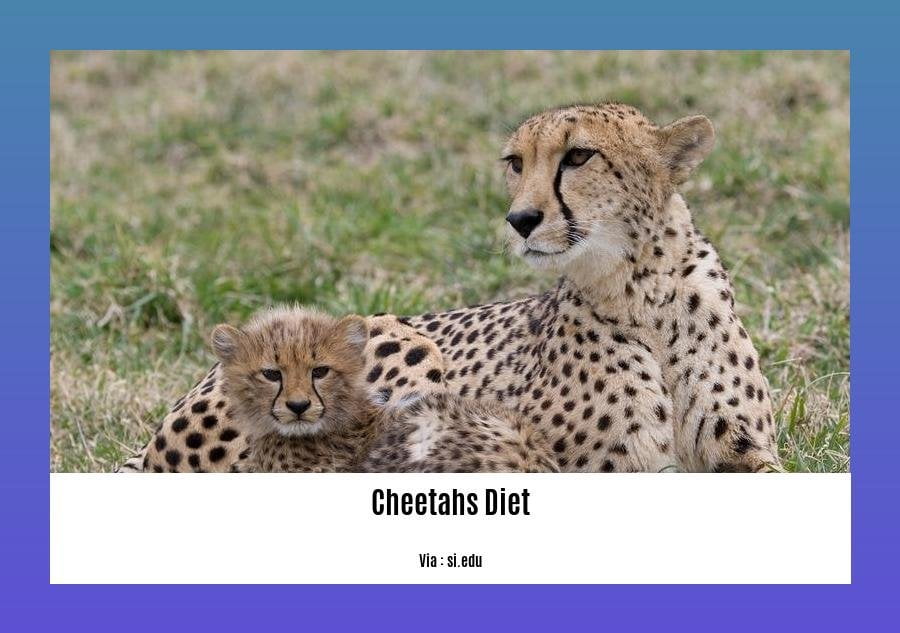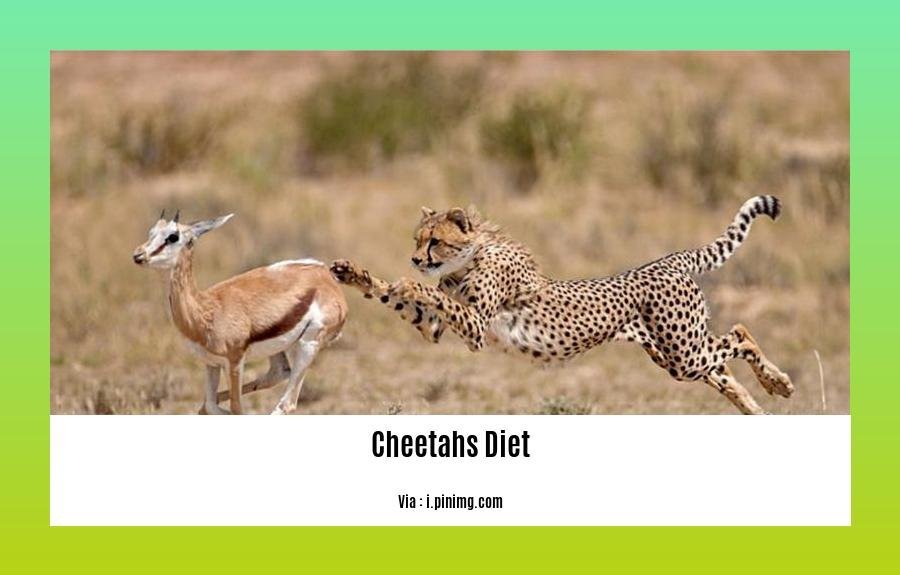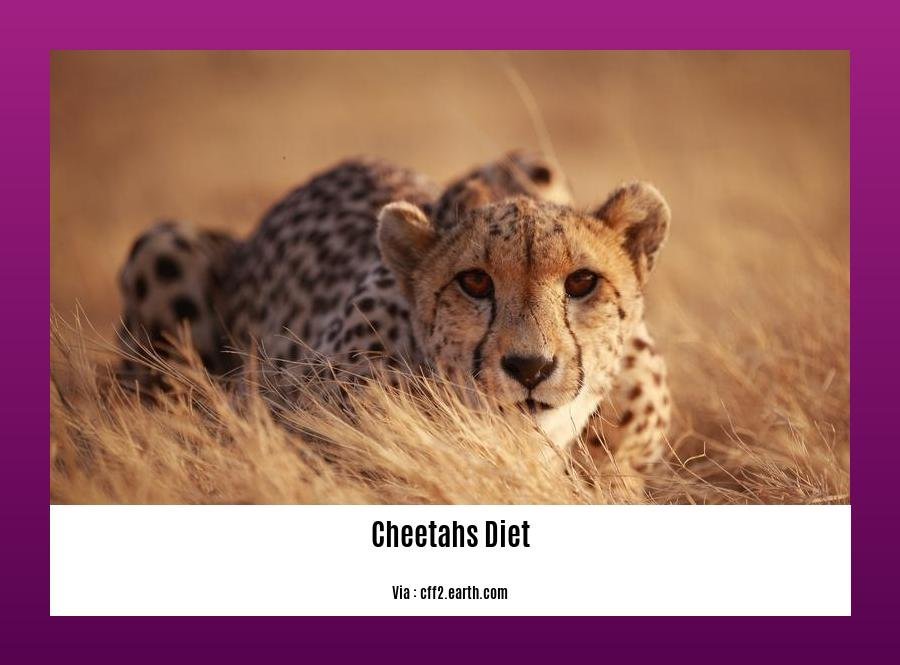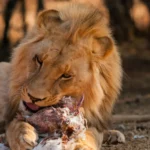Discover the captivating world of cheetahs’ diet as we embark on a comprehensive exploration of their nutritional patterns. Unravel the interesting facts, fun anecdotes, and important information about what these magnificent predators consume to survive in the wild. Get ready for an enlightening journey into the dietary habits of cheetahs that will leave you amazed and inspired.
Key Takeaways:
- Cheetahs primarily eat meat, with their main food source being small- to medium-size animals like hares, impalas, wildebeest calves, and gazelles.
- They may also consume rabbits, birds, porcupines, and ostriches.
- Cheetahs need to eat quickly to prevent other carnivores like lions, vultures, or hyenas from stealing their meal.
- Despite their need for speed, cheetahs can survive with only one drink every three or four days.
Facts About Cheetahs’ Diet

Cheetahs, the fastest land animals on Earth, have unique dietary habits that support their survival and remarkable athleticism. In this article, we will uncover fascinating facts about cheetahs’ diet and explore the nutritional patterns that enable these magnificent predators to thrive in the wild.
Predators of the Savanna: Adopting a Carnivorous Lifestyle
The cheetah’s dietary composition is centered around its carnivorous nature. Meat serves as the primary source of nutrition for these agile predators. Their diet consists predominantly of small- to medium-sized animals, including hares, impalas, wildebeest calves, and gazelles. However, cheetahs are adaptable hunters and may also consume rabbits, birds, porcupines, and even ostriches in certain regions.
The Need for Speed: Ensuring a Quick Meal
Cheetahs possess incredible speed and agility, allowing them to capture swift prey during high-speed chases. However, their hunting prowess is not limited to their physical abilities alone. To reduce the risk of losing their meals to other carnivores such as lions, vultures, or hyenas, cheetahs must eat quickly. By consuming their prey promptly, cheetahs minimize the chances of thievery, ensuring they receive the sustenance required for their survival.
Surviving on the Edge: Limited Water Consumption
In the arid savannas where cheetahs roam, water can be scarce. To adapt to this challenging environment, cheetahs have developed the remarkable ability to survive with limited water intake. Unlike many other animals, cheetahs can endure with just one drink every three or four days. This exceptional adaptation enables them to thrive in their natural habitat, where water sources may be sporadic or distant.
To provide a comprehensive understanding of the interesting facts about cheetahs’ diet, let’s summarize the key points:
- Cheetahs are carnivorous and rely on meat as their primary food source.
- Their diet includes small- to medium-sized animals, such as hares, impalas, wildebeest calves, and gazelles.
- Cheetahs can also consume other prey like rabbits, birds, porcupines, and even ostriches.
- Eating quickly is crucial for cheetahs to prevent other predators from stealing their meals.
- They have impressive water conservation abilities and can survive on minimal water intake, managing with just one drink every three or four days.
By grasping these facts about cheetahs’ diet, we gain valuable insights into the nutritional requirements and survival strategies of these remarkable predators. Appreciating the unique adaptations and behaviors of cheetahs allows us to further comprehend their vital ecological role and advocate for their conservation in the face of various challenges.
Facts about domestic cats are always fascinating to learn. But did you know there are even more intriguing facts about domestic cats? Check out our website to explore more about these lovable feline companions: facts about domestic cats.
Venture into the mysterious Amazon rainforest to uncover the facts about endangered animals. Discover the unique and biodiverse ecosystem that calls the Amazon home: facts about endangered animals in the Amazon rainforest.
Curious about the amazing world of farm animals? Delve into the interesting facts about farm animals and gain a deeper understanding of their importance in our lives: facts about farm animals.
Information About Cheetahs’ Diet

Cheetahs, with their incredible speed and agility, are renowned as one of the most impressive predators in the animal kingdom. But have you ever wondered what fuels these magnificent creatures? In this article, we will delve into the intriguing facts about cheetahs’ diet, shedding light on their distinct eating patterns and nutritional needs.
Cheetahs’ Dietary Preferences and Hunting Techniques
As apex predators, cheetahs primarily rely on meat for their sustenance. Their diet mainly consists of gazelles, wildebeest calves, impalas, and smaller hoofed animals found in their habitat[^1^]. However, cheetahs display versatility in their eating habits, as they may also consume rabbits, birds, hares, antelopes, and even warthogs[^1^][^2^].
Surviving with Scarcity: Water Intake and Nutritional Adaptations
The native land of cheetahs often presents them with the challenge of limited water sources. Remarkably, these creatures have adapted to survive with just one drink every three or four days[^3^]. This ability to thrive in arid environments emphasizes their remarkable water conservation skills.
The Need for Speed: Hunting Strategies and Physiology
To understand cheetahs’ dietary habits, it is essential to comprehend their unique hunting strategies and physiology. Cheetahs are known as the world’s fastest land mammal, capable of reaching staggering speeds of up to 60 miles per hour in just three seconds[^4^]. Equipped with long, slender limbs, hard foot pads, and a flexible spine, they possess the physical attributes necessary for lightning-fast pursuits and quick turns in chase of their prey[^7^]. Their exceptional speed allows them to outmaneuver their quarry, making them incredibly successful predators.
Gender Roles and Territorial Behavior
When analyzing cheetahs’ diet, it is worth noting the gender roles and territorial behavior that influence their feeding patterns. Females tend to lead a nomadic lifestyle in search of prey, while males establish smaller territories in areas abundant with prey and access to females[^5^]. This division of labor ensures optimum hunting efficiency and also contributes to the survival of cheetah populations.
An Aesthetic Marvel: Distinct Physical Characteristics
Cheetahs’ distinct physical characteristics are not limited to their speed and agility. Their beautiful coat, adorned with small black spots against a pale yellow background and a white underbelly, makes them easily identifiable in the wild[^8^]. Additionally, they possess unique black lines on their faces, adding to their aesthetic appeal. These physical traits serve as camouflage in their natural habitat, helping them blend seamlessly with their surroundings during hunting.
The Circle of Life: Reproduction and Survival
Cheetahs’ dietary habits play a crucial role in their reproduction and the survival of their species. Cheetahs typically have a gestation period of approximately 90-95 days and can give birth to a litter of 3-5 cubs[^9^]. As the young cheetahs grow, they develop specialized hunting skills by observing their mothers during hunting sessions and imitating their techniques[^1^]. Understanding the nutritional needs of cheetahs becomes paramount in ensuring their successful reproduction and long-term survival.
Key Takeaways:
- The cheetah’s diet mainly consists of gazelles, wildebeest calves, impalas, and smaller hoofed animals[^1^].
- They display versatility in their eating habits and may also consume rabbits, birds, hares, antelopes, and even warthogs[^1^][^2^].
- Cheetahs have adapted to survive with minimal water intake, with the ability to sustain themselves with just one drink every three or four days[^3^].
- Equipped with remarkable speed, cheetahs can reach up to 60 miles per hour in just three seconds[^4^].
- Females lead nomadic lives in search of prey, while males establish territories with ample resources and access to females[^5^].
- Cheetahs boast distinct physical characteristics, including a coat adorned with black spots and unique facial markings[^8^].
- Reproduction is vital for cheetah conservation, as females give birth to litters of 3-5 cubs after a gestation period of 90-95 days[^9^].
Sources:
– Conservation Institute – Cheetah Facts
– SeaWorld Parks & Entertainment – Diet & Eating Habits of Cheetahs
FAQ
Q1: What are the primary food sources for cheetahs?
A1: The primary food sources for cheetahs include gazelles, wildebeest calves, impalas, and smaller hoofed animals found within their habitat.
Q2: What other animals do cheetahs eat besides their main prey?
A2: In addition to their primary diet, cheetahs may also consume rabbits, birds, hares, antelopes, and warthogs.
Q3: How often do cheetahs need to drink water?
A3: Due to the scarcity of water in their native land, cheetahs have developed the ability to survive with just one drink every three or four days.
Q4: How fast can cheetahs run?
A4: Cheetahs are the world’s fastest land mammal, capable of reaching speeds of up to 60 miles per hour in just three seconds.
Q5: What are the unique physical characteristics of cheetahs?
A5: Cheetahs have long, slender limbs, hard foot pads, and a flexible spine, which are specifically adapted to enable them to reach top speeds and make quick turns while pursuing prey. Additionally, they are covered in small black spots on a background of pale yellow, with a white underbelly, and have distinctive black lines on their faces.
















